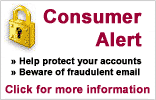
Please click "Continue" or you will be logged out.
Logging out
Online & Mobile Services
Internet Security Information
 Consumer Alert Information
Consumer Alert Information
 MultiKey Login Information
MultiKey Login Information
Our bank is dedicated to making information security one of our highest priorities.
We utilize the latest software, hardware and other technologies to prevent unauthorized
users from accessing our computer systems.
 We have implemented many different levels of security including
User ID, password, encryption of sensitive data, and others. We utilize a technology
called SSL (Secure Socket Layer). SSL is software to secure and protect web site
communication using encrypted transmission of data. The SSL creates a secure communications
channel between our Internet Banking server and your browser.
We have implemented many different levels of security including
User ID, password, encryption of sensitive data, and others. We utilize a technology
called SSL (Secure Socket Layer). SSL is software to secure and protect web site
communication using encrypted transmission of data. The SSL creates a secure communications
channel between our Internet Banking server and your browser.
The following are some of the technologies we have implemented to ensure all transactions are secure:
Username and Password Protection
To access account information, you must provide a username and a password to enter
the secure area of the site. Your password is not displayed when entered. If you
do not provide this information, we cannot establish an online banking service for
you.
What can I do?
Don't let anyone else know your password. Never write it down where anyone can find
it. We also recommend that you change your password every 30 days or sooner. Use
letters (upper and lower case), numbers, symbols. Use a different password for different
internet websites. Don't use the same password for all of your websites that require
you to login. Never access the online banking site from a computer or terminal that
an untrusted individual or the general public may have access to. You should also
take the standard precautions to keep your computer free from viruses.
Always Log Out
You should always log out of the online banking site when you are finished or if
you are going to be away from your computer for an extended period of time. The
log out will end your session, and you will be required to enter your User ID and
password before entering the online banking website again.
If you have not accessed the internet banking for a period of time, your login session
will automatically timeout. To start a new session, you will be required to enter
your User ID and password on the login page.
Remember that once you've downloaded the proper browser, you must install it on
your computer. Follow the browser manufacturer's instructions that appear on your
screen.
Secure Sockets Layer (SSL)
After you are connected with a website that is secure, you will see a padlock or
key icon on your browser that shows being locked or connected. This icon will only
appear after you have gone to the Login web page. The padlock or key icon may not
appear locked on pages where you are not logged on and where general information
is displayed about the site. However, you can be assured that any screen which displays
or requests information about your account, username, password or any other sensitive
information is encrypted.
If you would like to read more information about SSL encryption, we recommend you
read
VeriSign's SSL Page
Network Security and Monitoring
Firewalls are an essential part of network security. They are used to protect your
internal network from external threats that can compromise data and data transmissions.
We are using our firewalls to monitor all transmissions from the internet. Our firewalls
create logs of network traffic that allow for centralized auditing and security
monitoring. We have also setup security policies on the firewall to stop any suspected
malicious activity.